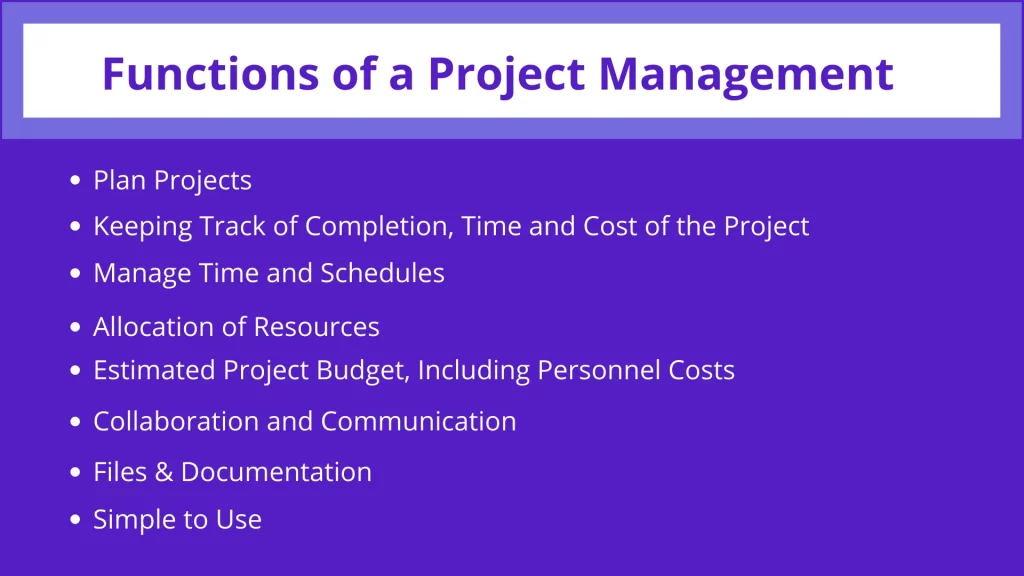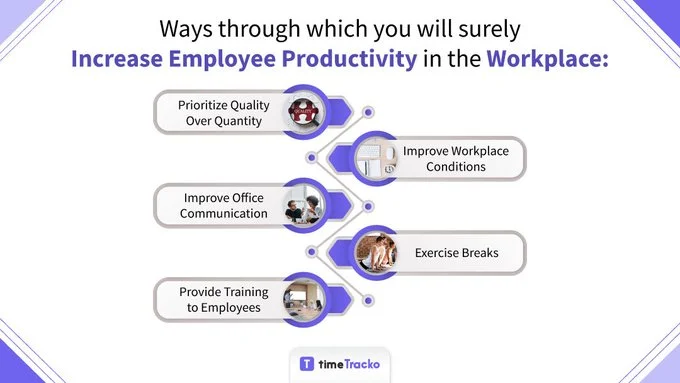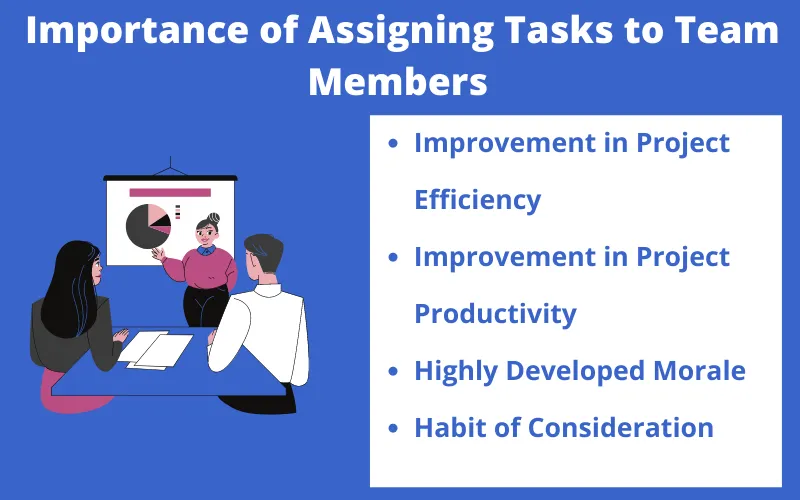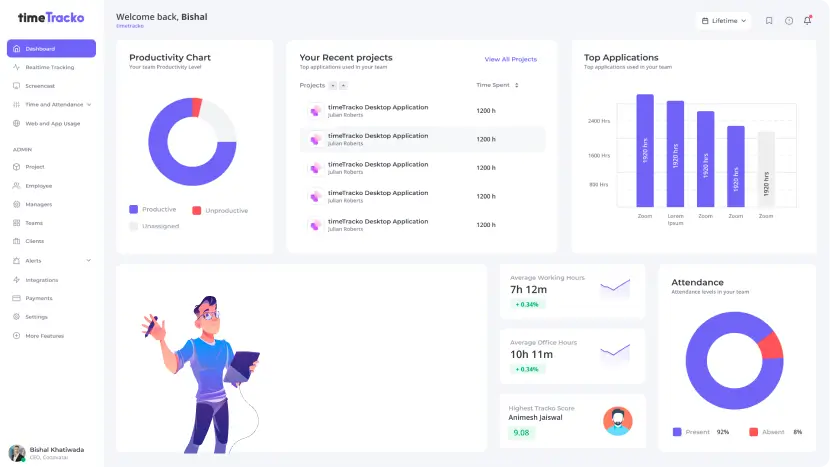<strong>How to Organize and Manage Projects at Work: Steps and Tips for Success</strong>
How to Organize and Manage Projects at Work: Steps and Tips for Success
“Management is, above all, a practice where art, science, and craft meet.” – Henry Mintzberg.
Managing projects is a difficult task. Whether you’ve worked on projects for years or this is your first, it’s always a challenge. Because when you are given the responsibility of managing a project, you must ensure that everything falls into place and is completed more efficiently.

While planning and managing a project is difficult, it saves time and effort. You must organize and manage your project expertly to succeed in business, especially in today’s competitive world.
According to the survey, “89 percent of businesses now have at least one project management office (PMO), with half having multiple PMOs.”
What Does it Mean to Be Organized?

The systematic coordination of structures, capabilities, and practices to achieve continuous improvement in the performance of temporary processes is referred to as organizing.
Organizers keep track of the tasks they need to complete and meet deadlines. It’s easier to collaborate with others when you’re organized, and you’ll be more productive and efficient.
Learn More: Best Ways To organize Multiple Projects Effectively💻💯
Benefits of Good Project Management
Today, every company wants to move forward while pushing its competitors backward at the same time. Thus, if you want your company to reach the top, you must manage your company’s projects inefficiently, since project management is the key to achieving success.
Here are some of the advantages of good project management to help you better understand it.
1) Save Time and Money:
Planning ahead will also help you complete your project on time and within budget. You can plan your project’s path from the start, knowing when deadlines and estimated costs will occur, allowing you to better allocate resources and avoid delays and project overspending.
Learn More: Importance of Time Management in the Workplace⏰✔️
2) Improve Team Collaboration:

Working together can be difficult because people in a company may come from different cities or countries, complicating communication and collaboration. Even when working across teams or departments, more efficient project management processes can reduce the complexity of collaboration, increase transparency, and ensure accountability.
Learn More: Importance of Team Collaboration in the Workplace🧑🤝🧑🤝
3)Continually Improve On Your Achievement:
With good project management, you can scale performance while also leveraging your team’s best practices. Using data and lessons learned from previous projects, you can identify where your team excels and where you need to improve. Your KPIs can also be used to track your team’s performance from project to project by tracking your KPIs.
4)Increase Your Productivity:
According to a survey,”80% of respondents admitted spending at least half of their time on rework, implying spending more time on the same project.” However, with good project management, you’ll be able to expand your services and find new business opportunities because there is no possibility of making a mistake that would necessitate rework.

As a result, you will be able to finish a project in less time and do more extra projects when you would have spent reworking and wasting time on the same project previously. Furthermore, excellent performance will undoubtedly increase the market for your services.
5) Customers Are Happier:
Project managers have the responsibility of keeping everyone happy, which is a reflection of the company’s success. When well managed, the project is completed quickly and professionally, and the customer is satisfied.
6) The Risk Will Be Controlled:
Because each project entails a certain level of risk, risk management is the most important thing to remember while working on any project. Even though it’s impossible to anticipate and mitigate every possible risk from the start, it’s still critical to identify and account for major risks.
We will identify risks early in the process and address them before they cause problems if we manage the project. You will save time, money, and other resources if you detect the problem early.
7) Clarifying Everyone’s Role Reduces Ambiguity:
Every project has a lot of people working on it. If the team’s work is not divided, there will be confusion among the team members. Multiple employees may be working on the same project simultaneously, wasting both time and money. As a result, if we divide each team member’s work, there will be no confusion. This will save time, money, and other resources for the project.
Challenges to Face While Organizing Projects
Are you aware of this? Project management is the most difficult task because even the most experienced project managers and problems can arise during the project life cycle. As a result, you must understand project challenges to avoid or overcome problems smoothly. You can take the following steps if you know what project management challenges you might face:
1) Setting Clear Goals and Objectives
According to a survey published in PM Network,” Nearly a third of project managers said their project failed because of unclear goals and objectives.”

There will be a lot of confusion if the project manager and team members don’t know what they’re working on, and you won’t be able to manage and allocate resources properly. So, the first step in any project should be to establish a clear goal and objective for what they are working on.
How to set clear goals and objectives
Step 1: Identify the project goal.
Step 2: Define the goals you have identified.
Step 3: Create an action plan.
Step 4:Set the plan into action
Step 5: Monitor project Execution.
2) Communication Breakdown
Any project relies heavily on communication, which determines a project’s success or failure. Team members will work well together if there is good communication, tasks will be assigned efficiently, and stakeholders will be updated on project progress. None of the above will happen if communication is poor.

How to deal with communication problems?
- Create a communication strategy.
- Have a few short stand-up meetings each week.
- Make use of a variety of project collaboration tools.
- Include all employees in the project discussion and provide them with an equal opportunity to express their opinions.
Learn More: How to Enhance your Team Communication? 🙋🏻♂️💬
3) Inadequate Skills on the Project Team
Technical skills, hard skills, and soft skills such as teamwork are the most important aspects of any project. Your project’s outcomes will almost certainly suffer if one team member lacks the necessary skills. As a result, you should assemble a team of highly skilled individuals.
How do you deal with a project team that lacks the necessary skills?
- Make a list of the skills you’ll need to complete the project, and then work on a specific project with them.
- If your team misses a skilled member, you can hire a freelancer for the project.
4) Budgeting Issue
Amongst the most important aspects of any project is money. Most project managers consider the cost the most significant project management challenge they face.

Budget mismanagement can cause a major problem during the project. You may occasionally be forced to leave a project due to poor management. As a result, proper budgeting should be done throughout any project.
How to deal with budgeting problems?
- A proper project scheduling tool, budgeting procedure, and realistic assumptions must be used to avoid huge costs.
- The project scope must be planned while keeping the budget in mind.
- Don’t spend too much time on a project because the more time you spend on it, the more money you’ll spend on it.
Learn more: Top 13 Budget Management Apps for Your Business💰
5) Improper Risk Management
Every project carries some amount of risk. It’s impossible to completely address every possible risk from the beginning; it is still important to identify and account for major risks. Projects rarely go exactly as planned because so many variables can create unlimited possibilities.
How do you deal with the Risk Management problem?
- Create a project risk management system to identify and mitigate different risks.
Tips to Organize and Manage Projects at Work Effectively
Workplace project management and organization can benefit businesses of all sizes. Listed below are a few of them:
- It improves the efficiency of all aspects of the business.
- It aids in staying on track and controlling costs and resources.
- Enhance work quality and productivity
- Boost customer happiness
- Improves your chances of getting the desired result
- Well-organized plans aid team collaboration.
- It teaches you how to manage the people and work on your projects using repeatable processes, guidelines, and techniques.
To achieve all the given advantages of organizing and managing the project at work, you need to follow the following steps:
1. Understand The Project
To make a project successful, the first and most important thing is to lay a solid foundation. To do so, you must first identify the clients and stakeholders and their goals and expectations for the project.
2. Understand The Project Specifications
The next crucial step is identifying the project requirements, as project resources are the most important factors in a project’s success.
The project’s intent, performance, and construction are all clearly stated in the specification. It can serve as a reminder of the standards and quality that should be followed. It is possible to clearly define materials and manufacturers’ products.
Understanding the Project Specifications: A Step-by-Step Approach
- Determine the basic things
- allow for a competitive bid
- provide a list of repeatable test methods for ensuring compliance with specifications.
- ensure that an equitable award is made at the lowest possible cost.
3. Determine The Available Resources
When working on a project, resources play an important role. Any project cannot be completed without resources. Workers, equipment, and money are examples of resources you may need to achieve your projective goal.
You will not have direct control over these resources as a project manager, but you will be responsible for managing them. But If you do not manage these resources while working on the project, you will run into problems in the middle of it, such as:
- Departmental Performance Is Unsatisfactory
- Unexpected setbacks occur frequently.
- Minor issues can quickly escalate into major financial issues.
Steps to Manage Resources
- Be careful not to overextend your resources.
- Establish Natural Deliverables
- Keep an eye on any unplanned tasks.
- Multitasking should be kept to a minimum.
4. Invest in an Experienced Project Manager
It’s critical to appoint a qualified project manager to ensure that the project moves in the right direction. A project manager with sufficient credibility will leave no stone unturned in ensuring the project’s success.

- He’d know how to lead a diverse group of people by delegating tasks to the appropriate individuals and ensuring that the process is both productive and enjoyable.
- He will put his trust in the team’s decisions and will intervene if something goes wrong.
- He understands how to earn clients’ trust and communicate their expectations to his team so that they can work together to achieve a common goal.
5. Prepare a Project Plan
Creating a detailed plan is the next step in any project. Make every effort to develop a strategy; the better the strategy, the better the project will turn out. When making a plan, you should create a question similar to the one below and respond to it.

- Make a list of how many people you’ll need to complete the project and what kind of qualifications they’ll need.
- What is your budget? And What amount of money will you require to finish your project?
- What will you need in terms of resources?
- What do you think it will take you to complete your task?
- Set up a meeting and ask all important questions before devising a strategy.
Steps to create a realistic project plan
- Compile a list of key stakeholders’ requirements.
- Establish the project’s parameters.
- Make a breakdown of the work that needs to be done.
- Define the activities involved in the project.
- Organize the activities of the project.
- Calculate the time, cost, and resources required for each activity.
- Work packages and activities should be assigned resources based on skills and interests.
- Make sure there are backup plans in place.
- Make a baseline for performance evaluation.
- All subsidiary plans should be completed.
- Every detail should be documented.
- Create a library of information.
6. Make A Schedule For The Project
Listing activities, deliverables, and milestones within a project are called scheduling in project management.
There are many similarities between a project plan and a project schedule.

After you’ve created a list of all the activities, determine their project dependencies and order them accordingly. You can now estimate the time and resources needed for each activity and confirm that your budget and timeline are sufficient.
To begin, ask yourself four questions during project scheduling:
- So, what’s the plan?
- When are you going to finish it?
- Who is going to take the initiative?
- What will be the location of the event?
Steps to create a project schedule
- Make a project scope document.
- Decide which tasks should be completed in which order.
- Tasks should be grouped.
- Task Dependencies should be linked.
- Discover the Essential Path.
- Assign resources to them.
7. Set A Deadline
You should set and follow deadlines when working on any project.

The deadline keeps you and your team responsible for your daily tasks and clarifies what is expected at any given time. It will also assist your project team in remaining focused on the tasks at hand rather than working on them on an as-needed basis. Setting and sticking to deadlines helps you finish your project on time and makes your customers happy.
Steps to set deadlines:
- Set deadlines that can be met.
- Make your deadlines more personable.
- Make use of the 80/20 rule.
- Make a list of reminders.
- Recognize how projects affect deadlines.
- Keep an eye on your coworkers’ limitations.
- Use Hofstadter’s Law to your advantage.
- Make a list of your deadlines.
8. Prioritize Your Goals
Have you ever paid attention? We frequently overlook prioritization and waste time, effort, and resources on unimportant things. So, whenever you’re working on a project, make a to-do list and determine what’s important and urgent for you, your team, and your company.
Steps for defining a prioritizing a task in the project:
- Make a to-do list.
- Examine each task’s importance.
- Improve your time management.
- Begin working.
- Be flexible and open to new experiences.
- When it’s time to say no, don’t be afraid to say it.
Learn more: Best to-do list apps📝
9. Exercise Effective Communication
A project cannot be successful without effective communication.
According to research, “poor communication is the cause of 56 percent of project failures.” This report demonstrates how crucial communication is during any project. As a result, good communication between project team members is essential.

Team members and stakeholders can be brought together by effective communication to agree on a project’s strategy, objectives, and budget. It can also aid everyone involved in the project to understand their roles, potentially increasing their willingness to support it. For better communication, you can use a variety of tools as well.
Steps to establish an effective communication:
- Be specific about your goals.
- Make internal communication easier to understand.
- Set up a communication channel with the client.
- Maintaining communication between internal departments.
- Updates and meetings on the status of the project.
Learn More: Communicating Styles At Work And How To Use Them🧑🤝🧑💬
10. Have Frequent Meetings
Meeting with your team regularly to check in and communicate project updates, including successes and issues, is critical.

Create a daily meeting to discuss your work and receive daily project updates, which will reduce the rate of employee cheating and laziness.
If you’re part of a virtual project team, you can hold meetings via various virtual communication channels such as Zoom, and Google Meet.
Steps to conduct effective meetings
- Participants to be chosen
- Agenda-setting
- The Meeting’s Start
- Setting the Rules of Engagement
- In Meetings, Time Management
- Taking a Look at the Meeting Process Taking a Look at the Meeting as a Whole
- The Meeting is now over.
11. Delegate Tasks Efficiently
“If you want to do a few small things right, do them yourself. If you want to do great things and make a big impact, learn to delegate.” -John C. Maxwell
Because you can’t or shouldn’t do everything yourself, all managers and leaders must master the art of delegation. Delegating tasks can help you manage your workload while empowering your team, building trust, and advancing your career. It also assists leaders in determining who is best suited to take on specific tasks or projects.

Realizing how or when to delegate tasks is crucial for maintaining a high level of productivity on both a personal and organizational level.
Steps for delegating tasks effectively
- Pick the right person for the job
- Keep your eye on the prize
- Be open to new ideas
- Give your team the authority to make decisions.
- Keep a check-and-balance system in place.
- Develop future leaders by motivating your team.
- Acquire the ability to say ‘thank you.’
Learn More: Guideline for Assigning Tasks to Team Members📝🧑🤝🧑
12. Anticipate Risks
Any potential event that can positively or negatively impact your project is considered a risk when working on it. Employee sickness, inclement weather, unexpected costs, and transportation delays are all examples of risks. As a result, risk management is critical.
Risk management is recognizing and responding to these events before or during their occurrence, and it aids in identifying risks before their occurrence and mitigating risks through early detection.
Steps for Anticipate Risks
- Determine the danger.
- Examine the danger
- Make the risk a top priority.
- Prepare a plan to deal with the risk.
- Keep a close eye on the danger.
13. Document Everything
There’s no doubt that project documentation plays a vital role in any project.
Documenting everything about the project provides benefits like:
- It makes sure that project requirements are fulfilled.
- It establishes traceability concerning what has been done, who has done it, and when it has been done.
- Gives you a better hold on project status.
- Facilitates good communication.
- Helps with better resource planning and assignment.
- Makes the project traceable.
- Keeps your focus intact.
Steps to document the project
- Gather all of your records in one place.
- Consider taking it one step at a time.
- Arrange the document and make it easy to find.
- Have your team review it before spreading it.
- Make sure the document is still relevant.
14. Keep Track Of Your Team’s Progress
Measuring progress on each task is one of the most critical aspects of a project manager’s job. Because In most projects, multiple team members are in charge of different aspects of the project simultaneously. You must keep track of the budget, scope, schedule, resources, and tasks to be completed.
As a result, the monitoring team assists employees in staying focused and Meeting goals and project managers in staying on top of what’s going on in the office.
Steps to keep track of your team’s progress:
- Make an all-team group discussion every morning to discuss each other’s work.
- Use a Progress Tracking Software like timeTracko to keep track of your progress.

timeTracko provides you facilities like:
- Automatic Time Tracking
- Automatic and unlimited Screenshot
- Screencast (Live Screen)
- Customize screencast report
- Productivity Labeling
- Time and Attendance
- URL and app Tracking
Learn More: Easy Tips for Employee Tracking👨💻✅
15. Use a different project management application:
After you’ve gone over all of the suggestions for managing and organizing projects, you can use project management software to make things even easier.
There are many tools on the market to help you manage and organize your project. Project management software is software used by various industries to plan projects, allocate resources, and schedule them. It allows project managers and entire teams to keep track of their budgets, quality management, and all project-related documentation.
MeisterTask, Basecamp, and Teamwork Projects are a few of them.
FAQs Regarding Organizing Projects Effectively
1. What are the 5 Steps to project success?
➡️ Define the Project’s objectives.
➡️ Create well-defined plans with clearly defined roles and responsibilities.
➡️ Keep a tight grip on the project’s scope.
➡️ Maintain effective communications at all times.
➡️ Ensure that your management team is on board.
2. How to organize ideas for a project?
➡️ Visualize your ideas
➡️ Create a mind map Establish a timeline
➡️ Make a checklist.
➡️ Find someone to talk to.
Conclusion
In this competitive generation, everyone is only concerned with how to push others backward while moving their own company forward. As a result, to propel your company to the top, you must inefficiently manage and organize your company’s project because the most important factor in achieving success is project management.
You can also use all ten steps outlined in this article to effectively manage and organize projects at work.

 in Melbourne
in Melbourne 
 Employee Screen Monitoring Software
Employee Screen Monitoring Software App and Website Monitoring Software
App and Website Monitoring Software Time and Attendance Software
Time and Attendance Software Finance
Finance Banking
Banking Healthcare
Healthcare Lawyers
Lawyers Retail & ecommerce
Retail & ecommerce Knowledge base
Knowledge base Blogs
Blogs Installation Guide
Installation Guide FAQs
FAQs About
About Media Kit
Media Kit Contact us
Contact us